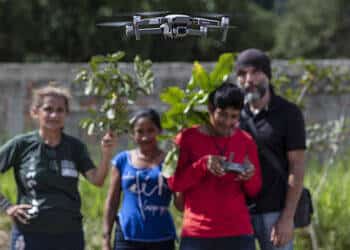With little support from governments amid rampant deforestation, Indigenous communities in Brazil are deploying drones to carry out their own Amazon surveillance.
As of mid-July, 25 monitoring kits had been delivered to five Indigenous communities in Brazilian states, thanks to support from organizations such as the World Wildlife Fund (WWF).
This includes the Uru-Eu-Wau-Wau community in the western state of Rondônia, who are frequent victims of land grabs and timber trafficking, and whose land continues to shrink, newspaper Folha de São Paulo reported. The program began in 2019, with training provided to Indigenous community members on how to use the drones, how to access the images, video and GPS data provided, and how to report to the authorities, according to CNN.
The project aims to provide a technological edge to monitor a host of criminal economies, including illegal logging, mining, fishing, and land grabbing, in the face of sustained government inaction in Brazil. Illegal deforestation in Brazil’s Amazon increased by 28 percent between August 2020 and July 2021, Science Magazine reported.
“There is little action by those responsible for combating deforestation in the Amazon…it is even more important that Indigenous groups themselves have ways to monitor [potential environmental crimes on their land] and try to defend their territories on their own,” WWF’s Felipe Spina told Folha.
SEE ALSO: GameChangers 2021: How Organized Crime Devoured the Amazon Rainforest
Drones significantly expand the range of land that communities can monitor, and allow them to record and report environmental crimes without running the risk of confronting criminal actors, who regularly kill land defenders. At least 19 land defenders were killed in Brazil in 2021, according to Mongabay.
Despite the threat of deforestation to the local communities and the environment, Amazon Basin governments have been unable or unwilling to tackle issues of deforestation, Folha reported. Almost all training and equipment has arrived from NGOs.
Similar projects have been employed in Peru and Ecuador, enhancing the surveillance capacities of Indigenous communities in some of the most critically affected areas of the Amazon. In Peru’s northern Loreto department, a deforestation hotspot that suffers from land invasions on behalf of large agricultural conglomerates, 36 Indigenous communities have received monitoring equipment and access to a centralized database for recording environmental crimes, Mongabay reported in 2020.
InSight Crime Analysis
Indigenous communities are considered to be among the best stewards of the Amazon’s biodiversity, but they face routine violence at the hands of illegal miners, loggers, fishers, and land invaders seeking to profit from its wealth.
SEE ALSO: 4 Reasons Why Ruin of Brazil’s Amazon Keeps Getting Worse
And the ability to better record illegal deforestation is difficult to turn into effective action.
In Brazil, the dismissive stance of President Jair Bolsonaro towards protecting the rainforest has led to a virtual complete lack of action against those invading Indigenous territories. In May, Folha de São Paulo reported that, since President Jair Bolsonaro came to power, less than three percent of all deforestation alerts led to inspections by authorities.
And in May 2021, the country’s environment minister and the head of its natural protection agency were put under investigation for allegedly helping timber companies illegally fell more wood than permitted.
In Peru and Ecuador, where governments have not been so cavalier towards environmental crimes, political chaos, social unrest, and worsening security have meant that protecting the rainforest has not been a major priority.

